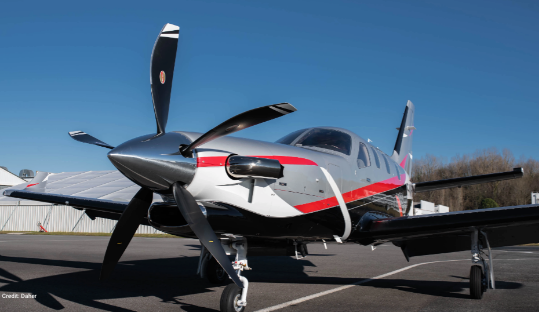Aircraft Overview: Daher TBM 940 & TBM 960
Aircraft Overview: Daher TBM 940 / TBM 960

TBM 940
The TBM 940 and TBM 960 are a pair of single-engine turboprops produced by French manufacturer Daher Aerospace.
Both airframes are commercial designations of the manufacturer’s TBM700 N type, with the TBM 940 being announced by Daher on March 7, 2019, and subsequently certified by the European Union Aviation Safety Agency (EASA) in May 2019.
The TBM 960 was unveiled on April 5, 2022, at the Sun ‘n Fun Aerospace Expo, replacing the TBM 940 as the “high-end version of” the airplane.
Both TBM700 N-based commercial designations are certified to a maximum passenger seating capacity of five, with those passengers accommodated in a cabin that has a maximum length of 13 ft. 3.45 in., maximum width of 3 ft. 11.64 in. and maximum height of 4 ft., as well as a maximum volume of 123 ft.3
When configured with four seats, the TBM 940 and TBM 960 can accommodate a maximum of 507 lb. of luggage “in storage areas,” a limitation that is reduced to 330 lb. when equipped with six seats.
Although those baggage limitations are shared by these versions of the TBM, the maximum luggage volume of the TBM 940 (30.25 ft.3) is slightly less than the same figure for TBM 960 (35 ft.3). Regarding avionics, the single pilot required for both of these turboprops utilizes Garmin’s G3000 integrated flight deck.
While the TBM 960 was announced in April 2022, that version of the TBM700 N was certified by EASA in March 2022, with the first delivery taking place taking place in May of that year.
Unlock the data behind the charts with Aviation Week Intelligence Network’s Fleet & Data Services. Learn more at aviationweek.com/bcaaircraftoverview.
For a comprehensive Program Profile including recent articles, program suppliers and current operators, please access via AWIN subscription here.
Variants
Another distinction between these TBM700 N commercial designations are the engines, with the TBM 940 powered by Pratt & Whitney Canada’s PT6A-66D, and the TBM 960 certified to be equipped with the PT6E-66XT.
The EASA type-certificate data sheet (TCDS) that includes the TBM700 N notes that the PT6A-66D has “maximum takeoff and continuous power” limitations of 850 shp, a limit that the PT6E-66XT increases to 895 shp.
Also distinguishing these Daher airframes are the basic empty and maximum weights—in addition to the maximum payloads—with the TBM 940 limited to a maximum takeoff weight (MTOW) of 7,394 lb. and a maximum landing weight of 7,024 lb., while having the ability to carry a maximum payload of 1,403 lb.
In comparison to the TBM 940, the TBM 960 increases the MTOW to 7,615 lb., maximum landing weight to 7,110 lb. and maximum payload to 1,446 lb. According to the airframe manufacturer, the basic empty weight of the former TBM is 4,629 lb., a weight that is increased to 4,806 lb. on TBM 960 with the Prestige cabin.
Furthermore, even though the TBM 940 and TBM 960 have a common usable fuel capacity of 292 gal., the maximum payloads when carrying full fuel differ (891 lb. and 888 lb., respectively).
Mission and Performance
Beyond having common cabin dimensions and volumes—as a well as maximum passenger seating capacities—the TBM 940 and TBM 960 also have several performance limitations in common, including a 271-kt. calibrated airspeed (KCAS) maximum operating speed (VMO) and 31,000-ft. maximum operating altitude.
Both versions of the TBM700 N are promoted as having the ability to climb to that maximum altitude in 18 min., 45 sec., while also capable of maximum ranges of 1,440 nm at 326-kt. true airspeed (KTAS), 1,585 nm at 290 KTAS and 1,730 nm at 252 KTAS.
Those range figures assume a single pilot, fuel reserve of 45 min., when operating at 31,000 ft. and carrying maximum fuel, the respective MTOW, International Standard Atmosphere (ISA) conditions and zero wind.
At 28,000 ft., the maximum cruise speed is 330 KTAS, while the “maximum cruise speed at long-range settings” is 252 KTAS.
Assuming 50-ft. obstacle clearance, ISA conditions, the airplane’s MTOW and zero wind, the takeoff distances of the TBM 940 and TBM 960 are 2,380-ft. and 2,535-ft., respectively. In contrast to those differing takeoff distances, both airframes are capable of a 2,430-ft. landing distance based on the criteria above.
Daher TBM 940 & 960 Images
Aviation Week Network is home to market-leading data and intelligence products. Find out which database is best for your business.
www.aircharterguide.com/
www.aircraftbluebook.com
www.acukwik.com/Products
www.airportdata.com
www.fleet.aviationweek.com